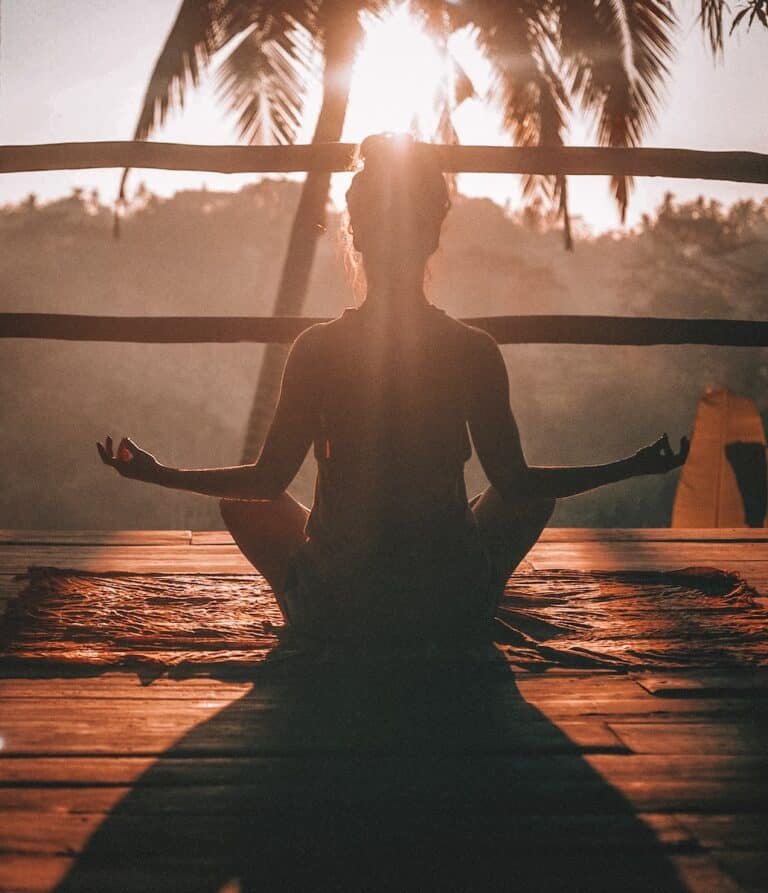Transform Your Life with Daily Stress Relief Meditation

Wellness Fixation is reader supported, meaning I may earn a small commission if you purchase something through my links at no extra cost to you. Thanks for your support! Learn more
Key Takeaways
Meditation can be a powerful tool for stress relief, accessible at any time and requiring just a few minutes of your day.
Practicing breathing techniques can help calm the mind and reduce stress levels significantly.
Incorporating a body scan into your daily routine promotes deep relaxation and awareness of bodily sensations.
Loving-kindness stress relief meditation fosters compassion and can improve interpersonal relationships and self-care.
Even short, simple mindfulness exercises can provide a quick stress relief meditation and help integrate meditation into a busy lifestyle.
Begin Your Journey to Serenity: The Essentials of Stress Relief Meditation
Life can be hectic. With the constant demands of work, family, and social obligations, finding a moment of peace might seem like a distant dream. But what if I told you that serenity could be just a few breaths away? That’s right, stress relief meditation is your secret weapon in the battle against the chaos of daily life. It’s a simple yet powerful practice that can help you find balance and calm in the midst of turmoil.
What Is Stress Relief Meditation?
At its core, stress relief meditation is about focusing your attention in a way that silences the chatter of the mind and soothes the nervous system. It’s not about achieving a mystical state or transforming into a Zen monk overnight. Instead, it’s about giving yourself the space to breathe, relax, and release the tension that builds up over the course of your day.
The Quick Impact of Daily Practice
Consistency is key. Just like you wouldn’t expect to get fit after a single trip to the gym, stress relief won’t happen from meditating once in a blue moon. But the good news is that it doesn’t take hours; even a few minutes each day can make a huge difference. The trick is to make it a habit, like brushing your teeth or having your morning coffee.
Mastering the Art of Breathing
Breathing is something we do without even thinking about it, but when you focus on it, it becomes an incredibly effective tool for calming the mind. Think about it – when you’re stressed, your breath becomes shallow and rapid. By consciously slowing and deepening your breath, you’re telling your body that it’s time to relax.
Here’s a simple breathing exercise to start with:
Find a comfortable seated position.
Close your eyes and take a slow, deep breath in through your nose.
Hold that breath for a count of four.
Exhale slowly through your mouth for a count of four.
Repeat this cycle for a few minutes, or as long as you need to feel a sense of calm.
Most importantly, remember that this is a practice. Some days it might feel easy, and other days it might feel like a challenge. That’s completely normal.
The Breath-Work Technique
As you become more comfortable with basic breathing exercises, you can explore different techniques. One popular method is the 4-7-8 technique, where you inhale for 4 seconds, hold for 7 seconds, and exhale for 8 seconds. This is known to help reduce anxiety and induce sleep.
Building a Routine Around Breath Awareness
Building a routine around breath awareness can be as simple as setting aside a few minutes each morning or evening to practice. You can do it while you’re still in bed, during a break at work, or even while waiting in line. The idea is to anchor your day with moments of mindfulness.
Therefore, let’s turn our attention to another powerful stress relief meditation technique – the body scan.
Body Scan: A Pathway to Deep Relaxation
The body scan is a form of meditation that involves paying close attention to different parts of your body, one by one, from your toes to the top of your head. It’s a way to get in touch with your body, identify any areas of tension or discomfort, and consciously relax them.
Here’s how to do a body scan:
Lie down or sit comfortably in a quiet space.
Close your eyes and take a few deep breaths to center yourself.
Focus on your feet. Notice any sensations you feel. Breathe into them, and as you exhale, imagine any tension melting away.
Gradually move your attention up your body, from your ankles to your calves, knees, thighs, and so on, up to your head.
Take your time and don’t rush. Allow yourself to really feel and relax each part of your body.
And remember, the goal isn’t to judge or change your experiences, but simply to be aware of them.

Step by Step Through Your Senses
As you move through the body scan, pay attention to your senses. What do you feel? Warmth? Coolness? Pressure? There’s no right or wrong here. It’s all about noticing and allowing whatever is there to be there without trying to change it.
Integrating the Body Scan into Your Evening Wind-Down
Integrating the body scan into your evening routine can be a great way to wind down before bed. It signals to your body that it’s time to rest and can improve the quality of your sleep. Besides that, it’s a moment just for you, away from the demands of your day.
The Ripple Effect on Daily Interactions
When you begin to practice stress relief meditation, something wonderful happens – it doesn’t just reduce your stress levels, it also positively impacts the way you interact with others. With a clearer mind and a calmer demeanor, you’ll find your conversations becoming more thoughtful and your relationships more harmonious.
Finding Moments for Mindfulness
One of the most beautiful things about mindfulness is that it doesn’t require a special time or place. It’s about being fully present in the moment, whether you’re washing dishes, taking a walk, or listening to a friend. Every moment is an opportunity for mindfulness and stress relief meditation.
Opportunities for Meditation in Everyday Life
Think of your daily life as a series of moments waiting to be filled with awareness. Waiting in line or stuck in traffic? Use that time to tune into your breath or the sensations in your body. Cooking dinner? Be mindful of the colors, textures, and smells. These pockets of mindfulness can become islands of calm in your day.
Short Practices for the Time-Pressed Individual
Even if you’re pressed for time, you can still benefit from meditation. Try these quick practices:
Take three conscious breaths every time you open a door.
Pause for a minute of silence before starting your car.
Use the moments before sleep to reflect on three things you’re grateful for.
Creating Your Meditation Space
A dedicated meditation space can greatly enhance your practice. It doesn’t have to be elaborate – just a quiet corner where you won’t be disturbed. This space will become a sanctuary for your mind, a place where stress begins to dissolve as soon as you enter.
Building an Oasis of Tranquility at Home
Your meditation space should feel inviting and calming. Consider adding items that soothe your senses, like a soft cushion, gentle lighting, or a scented candle. The key is to create an environment that helps you transition from the hustle and bustle of your day into a more serene state.

Tools and Ambiance That Support Your Practice
There are a few simple tools that can support your meditation practice:
A comfortable seat or cushion to encourage proper posture.
Headphones or speakers for guided meditations or calming music.
A timer to keep track of your sessions without distraction.
Meditation Milestones: Tracking Your Progress
As with any new skill, it’s helpful to track your progress in meditation. This isn’t about reaching a certain level or achieving perfection – it’s about recognizing your commitment and celebrating the positive changes in your life.
Recognizing and Celebrating Small Wins
Maybe you notice that you’re not as reactive to stressors as you used to be, or that you’re sleeping better. These small wins are significant milestones in your meditation journey and deserve to be acknowledged.
Adjusting Practices as You Grow
Your stress relief meditation practice will evolve with you. Over time, you may find that you prefer longer sessions, or that you’re drawn to different types of meditation. Listen to your body and mind, and adjust your practice accordingly.
Mindfulness Meditation: The Anchor in Stressful Times
Mindfulness meditation can be your anchor during stressful times, helping you to stay grounded and calm regardless of what’s happening around you. It teaches you to observe your thoughts and feelings without getting swept away by them.
Mindfulness Techniques for Instant Calm
Here are some quick mindfulness techniques you can use anytime, anywhere:
Focus on the sensation of your feet on the ground to bring you back to the present.
Take a “senses pause” and note one thing you can see, hear, touch, taste, and smell.
Use the “STOP” method: Stop, Take a breath, Observe your thoughts and feelings, Proceed with more awareness.
Mindfulness is like a muscle – the more you use it, the stronger it becomes. And as it strengthens, it becomes a natural response to stress, helping you to navigate life’s ups and downs with greater ease.
Cultivating Mindfulness as a Natural Response to Stress
As you practice mindfulness regularly, it starts to spill over into every aspect of your life. You’ll find yourself pausing to breathe before responding in a stressful situation, or noticing the beauty in a mundane task. This shift in perspective is a powerful tool for stress management.
Overcoming Common Meditation Challenges
It’s normal to encounter challenges in your stress relief meditation practice. Maybe you can’t seem to quiet your mind, or you find yourself getting sleepy. These are common experiences, and with a few adjustments, you can overcome them.
Addressing Frustrations and Plateaus
If you’re feeling stuck or frustrated, it might be time to shake things up. Try a different type of meditation, adjust the length of your sessions, or even meditate at a different time of day. Remember, the journey of meditation is personal and unique to you.
Addressing Frustrations and Plateaus
It’s completely natural to hit a wall in your meditation practice, where you feel like you’re not making progress. This is often a sign that you’re about to level up in your practice. Stay the course, but be willing to experiment. Sometimes, changing your meditation environment or trying a new meditation technique can provide a fresh perspective and renew your enthusiasm.
Maintaining Momentum in Your Practice
To keep the momentum going, set small, achievable goals for your practice. Maybe it’s meditating for five minutes every day for a week, or trying a new stress relief meditation style each month. Tracking these goals in a journal can help you see your progress over time, which is incredibly rewarding and motivating.
Picking the Right Meditation Apps and Tools
With technology at our fingertips, finding the right meditation apps and tools has never been easier. These resources can guide you through different practices, track your progress, and even remind you to meditate. However, with so many options available, it’s important to choose the ones that align with your needs and preferences.
App Features That Enhance Your Practice
When selecting a meditation app, look for features like:
A variety of guided meditations to keep your practice fresh.
- Progress tracking to celebrate your milestones.
- Customizable reminders to help you stay consistent.
Some apps also offer community features, allowing you to connect with other meditators, which can be a great source of support and inspiration.
Free vs. Paid Meditation Resources
There are many free meditation resources available, including apps, podcasts, and YouTube channels. These can be a great starting point for beginners. However, if you’re looking for more in-depth guidance or advanced features, investing in a paid app or subscription service may be worthwhile.
Frequently Asked Questions (FAQ)
Here are some common questions and answers to help you deepen your understanding of meditation for stress relief:
How Long Should I Meditate for Stress Relief?
The duration of your stress relief meditation sessions can vary based on your personal schedule and level of experience. As a beginner, starting with just a few minutes a day can be beneficial. As you get more comfortable, you may wish to gradually increase the time. The key is consistency, not duration. For those interested in yoga as a form of stress relief, consider exploring yoga for stress relief as a complementary practice.
Research suggests that even short periods of meditation can reduce stress. For example:
One study found that just 10 minutes of daily meditation can improve focus and calmness.
And here’s a quick guide to help you get started:
Beginner: 5-10 minutes daily
Intermediate: 10-20 minutes daily
Advanced: 20+ minutes daily or multiple short sessions throughout the day
Is It Better to Meditate in the Morning or at Night for Stress?
The best time to meditate is when you can do so consistently. Morning meditation can set a calm tone for the day, while evening stress relief meditation can help you unwind and reflect. Experiment with different times to see what feels right for you and fits into your lifestyle.
Can Meditation Actually Help with Long-Term Stress?
Absolutely. Meditation is not just a quick fix; it’s a skill that, when practiced regularly, can fundamentally change your relationship with stress. Over time, it can help you develop a more resilient and responsive approach to life’s challenges, leading to lasting reductions in stress.
What Should I Do If I Can’t Seem to Quiet My Mind?
It’s a common misconception that meditation is about silencing your thoughts. Rather, it’s about noticing your thoughts without getting caught up in them. When you find your mind wandering, gently guide your focus back to your breath or the object of your meditation. This is the practice.
Are Guided Meditations or Silent Meditations Better for Stress Relief?
Both guided and silent meditations can be effective for stress relief. Guided meditations can be especially helpful for beginners, as they provide structure and direction. As you become more experienced, you may enjoy the freedom of silent meditation. Ultimately, the best approach is the one that resonates with you and keeps you engaged in your practice.






